+ Open data
Open data
- Basic information
Basic information
| Entry | Database: PDB / ID: 5wua | |||||||||
|---|---|---|---|---|---|---|---|---|---|---|
| Title | Structure of a Pancreatic ATP-sensitive Potassium Channel | |||||||||
 Components Components |
| |||||||||
 Keywords Keywords |  TRANSPORT PROTEIN / TRANSPORT PROTEIN /  KATP / channel / KATP / channel /  ABC transporter / Kir ABC transporter / Kir | |||||||||
| Function / homology |  Function and homology information Function and homology information ATP sensitive Potassium channels / response to resveratrol / ventricular cardiac muscle tissue development / ATP-activated inward rectifier potassium channel activity / cell body fiber / inward rectifying potassium channel / Regulation of insulin secretion / ATP sensitive Potassium channels / response to resveratrol / ventricular cardiac muscle tissue development / ATP-activated inward rectifier potassium channel activity / cell body fiber / inward rectifying potassium channel / Regulation of insulin secretion /  sulfonylurea receptor activity / CAMKK-AMPK signaling cascade / ABC-family proteins mediated transport ... sulfonylurea receptor activity / CAMKK-AMPK signaling cascade / ABC-family proteins mediated transport ... ATP sensitive Potassium channels / response to resveratrol / ventricular cardiac muscle tissue development / ATP-activated inward rectifier potassium channel activity / cell body fiber / inward rectifying potassium channel / Regulation of insulin secretion / ATP sensitive Potassium channels / response to resveratrol / ventricular cardiac muscle tissue development / ATP-activated inward rectifier potassium channel activity / cell body fiber / inward rectifying potassium channel / Regulation of insulin secretion /  sulfonylurea receptor activity / CAMKK-AMPK signaling cascade / ABC-family proteins mediated transport / voltage-gated monoatomic ion channel activity involved in regulation of presynaptic membrane potential / Ion homeostasis / sulfonylurea receptor activity / CAMKK-AMPK signaling cascade / ABC-family proteins mediated transport / voltage-gated monoatomic ion channel activity involved in regulation of presynaptic membrane potential / Ion homeostasis /  inward rectifier potassium channel activity / ATPase-coupled monoatomic cation transmembrane transporter activity / inward rectifier potassium channel activity / ATPase-coupled monoatomic cation transmembrane transporter activity /  nervous system process / regulation of monoatomic ion transmembrane transport / inorganic cation transmembrane transport / nervous system process / regulation of monoatomic ion transmembrane transport / inorganic cation transmembrane transport /  action potential / action potential /  ankyrin binding / response to ATP / response to testosterone / potassium ion import across plasma membrane / ankyrin binding / response to ATP / response to testosterone / potassium ion import across plasma membrane /  voltage-gated potassium channel activity / voltage-gated potassium channel activity /  potassium ion binding / regulation of insulin secretion / potassium ion binding / regulation of insulin secretion /  axolemma / axolemma /  intercalated disc / negative regulation of insulin secretion / ABC-type transporter activity / potassium ion transmembrane transport / intercalated disc / negative regulation of insulin secretion / ABC-type transporter activity / potassium ion transmembrane transport /  T-tubule / T-tubule /  heat shock protein binding / heat shock protein binding /  regulation of membrane potential / acrosomal vesicle / response to ischemia / determination of adult lifespan / cellular response to glucose stimulus / positive regulation of protein localization to plasma membrane / regulation of membrane potential / acrosomal vesicle / response to ischemia / determination of adult lifespan / cellular response to glucose stimulus / positive regulation of protein localization to plasma membrane /  sarcolemma / potassium ion transport / cellular response to nicotine / glucose metabolic process / response to estradiol / sarcolemma / potassium ion transport / cellular response to nicotine / glucose metabolic process / response to estradiol /  presynaptic membrane / presynaptic membrane /  nuclear envelope / cellular response to tumor necrosis factor / transmembrane transporter binding / response to hypoxia / nuclear envelope / cellular response to tumor necrosis factor / transmembrane transporter binding / response to hypoxia /  endosome / response to xenobiotic stimulus / neuronal cell body / glutamatergic synapse / apoptotic process / endosome / response to xenobiotic stimulus / neuronal cell body / glutamatergic synapse / apoptotic process /  ATP hydrolysis activity / ATP hydrolysis activity /  ATP binding / ATP binding /  plasma membrane plasma membraneSimilarity search - Function | |||||||||
| Biological species |   Mus musculus (house mouse) Mus musculus (house mouse)synthetic construct (others)   Mesocricetus auratus (golden hamster) Mesocricetus auratus (golden hamster) | |||||||||
| Method |  ELECTRON MICROSCOPY / ELECTRON MICROSCOPY /  single particle reconstruction / single particle reconstruction /  cryo EM / Resolution: 5.6 Å cryo EM / Resolution: 5.6 Å | |||||||||
 Authors Authors | Li, N. / Wu, J.-X. / Chen, L. / Gao, N. | |||||||||
| Funding support |  China, 2items China, 2items
| |||||||||
 Citation Citation |  Journal: Cell / Year: 2017 Journal: Cell / Year: 2017Title: Structure of a Pancreatic ATP-Sensitive Potassium Channel. Authors: Ningning Li / Jing-Xiang Wu / Dian Ding / Jiaxuan Cheng / Ning Gao / Lei Chen /  Abstract: ATP-sensitive potassium channels (K) couple intracellular ATP levels with membrane excitability. These channels play crucial roles in many essential physiological processes and have been implicated ...ATP-sensitive potassium channels (K) couple intracellular ATP levels with membrane excitability. These channels play crucial roles in many essential physiological processes and have been implicated extensively in a spectrum of metabolic diseases and disorders. To gain insight into the mechanism of K, we elucidated the structure of a hetero-octameric pancreatic K channel in complex with a non-competitive inhibitor glibenclamide by single-particle cryoelectron microscopy to 5.6-Å resolution. The structure shows that four SUR1 regulatory subunits locate peripherally and dock onto the central Kir6.2 channel tetramer through the SUR1 TMD0-L0 fragment. Glibenclamide-bound SUR1 uses TMD0-L0 fragment to stabilize Kir6.2 channel in a closed conformation. In another structural population, a putative co-purified phosphatidylinositol 4,5-bisphosphate (PIP) molecule uncouples Kir6.2 from glibenclamide-bound SUR1. These structural observations suggest a molecular mechanism for K regulation by anti-diabetic sulfonylurea drugs, intracellular adenosine nucleotide concentrations, and PIP lipid. | |||||||||
| History |
|
- Structure visualization
Structure visualization
| Movie |
 Movie viewer Movie viewer |
|---|---|
| Structure viewer | Molecule:  Molmil Molmil Jmol/JSmol Jmol/JSmol |
- Downloads & links
Downloads & links
- Download
Download
| PDBx/mmCIF format |  5wua.cif.gz 5wua.cif.gz | 954.5 KB | Display |  PDBx/mmCIF format PDBx/mmCIF format |
|---|---|---|---|---|
| PDB format |  pdb5wua.ent.gz pdb5wua.ent.gz | 701.4 KB | Display |  PDB format PDB format |
| PDBx/mmJSON format |  5wua.json.gz 5wua.json.gz | Tree view |  PDBx/mmJSON format PDBx/mmJSON format | |
| Others |  Other downloads Other downloads |
-Validation report
| Arichive directory |  https://data.pdbj.org/pub/pdb/validation_reports/wu/5wua https://data.pdbj.org/pub/pdb/validation_reports/wu/5wua ftp://data.pdbj.org/pub/pdb/validation_reports/wu/5wua ftp://data.pdbj.org/pub/pdb/validation_reports/wu/5wua | HTTPS FTP |
|---|
-Related structure data
| Related structure data |  6689MC M: map data used to model this data C: citing same article ( |
|---|---|
| Similar structure data |
- Links
Links
- Assembly
Assembly
| Deposited unit | 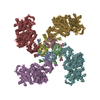
|
|---|---|
| 1 |
|
- Components
Components
| #1: Protein | Mass: 76339.242 Da / Num. of mol.: 4 Source method: isolated from a genetically manipulated source Details: ATP-sensitive inward rectifier potassium channel 11 with C-terminal synthetic superfolder GFP and affinity tags added Source: (gene. exp.)   Mus musculus (house mouse), (gene. exp.) synthetic construct (others) Mus musculus (house mouse), (gene. exp.) synthetic construct (others)Gene: Kcnj11 / Cell line (production host): HEK / Production host:   Homo sapiens (human) / References: UniProt: Q61743 Homo sapiens (human) / References: UniProt: Q61743#2: Protein |  ABCC8 / Sulfonylurea receptor 1 ABCC8 / Sulfonylurea receptor 1Mass: 177296.578 Da / Num. of mol.: 4 Source method: isolated from a genetically manipulated source Source: (gene. exp.)   Mesocricetus auratus (golden hamster) / Cell line (production host): HEK / Production host: Mesocricetus auratus (golden hamster) / Cell line (production host): HEK / Production host:   Homo sapiens (human) / References: UniProt: A0A1S4NYG1*PLUS Homo sapiens (human) / References: UniProt: A0A1S4NYG1*PLUS |
|---|
-Experimental details
-Experiment
| Experiment | Method:  ELECTRON MICROSCOPY ELECTRON MICROSCOPY |
|---|---|
| EM experiment | Aggregation state: PARTICLE / 3D reconstruction method:  single particle reconstruction single particle reconstruction |
- Sample preparation
Sample preparation
| Component |
| ||||||||||||||||||||||||
|---|---|---|---|---|---|---|---|---|---|---|---|---|---|---|---|---|---|---|---|---|---|---|---|---|---|
| Molecular weight | Value: 880 kDa/nm / Experimental value: NO | ||||||||||||||||||||||||
| Source (natural) |
| ||||||||||||||||||||||||
| Source (recombinant) |
| ||||||||||||||||||||||||
| Buffer solution | pH: 7.5 | ||||||||||||||||||||||||
| Specimen | Embedding applied: NO / Shadowing applied: NO / Staining applied : NO / Vitrification applied : NO / Vitrification applied : YES : YES | ||||||||||||||||||||||||
Vitrification | Cryogen name: ETHANE |
- Electron microscopy imaging
Electron microscopy imaging
| Experimental equipment |  Model: Titan Krios / Image courtesy: FEI Company |
|---|---|
| Microscopy | Model: FEI TITAN KRIOS |
| Electron gun | Electron source : :  FIELD EMISSION GUN / Accelerating voltage: 300 kV / Illumination mode: FLOOD BEAM FIELD EMISSION GUN / Accelerating voltage: 300 kV / Illumination mode: FLOOD BEAM |
| Electron lens | Mode: BRIGHT FIELD Bright-field microscopy Bright-field microscopy |
| Image recording | Electron dose: 40 e/Å2 / Detector mode: INTEGRATING / Film or detector model: FEI FALCON II (4k x 4k) |
- Processing
Processing
| EM software | Name: relion / Version: 2 / Category: 3D reconstruction |
|---|---|
CTF correction | Type: PHASE FLIPPING AND AMPLITUDE CORRECTION |
| Symmetry | Point symmetry : C4 (4 fold cyclic : C4 (4 fold cyclic ) ) |
3D reconstruction | Resolution: 5.6 Å / Resolution method: FSC 0.143 CUT-OFF / Num. of particles: 34500 / Symmetry type: POINT |
 Movie
Movie Controller
Controller



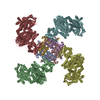

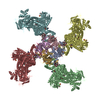
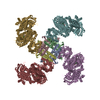



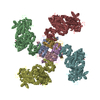
 PDBj
PDBj






